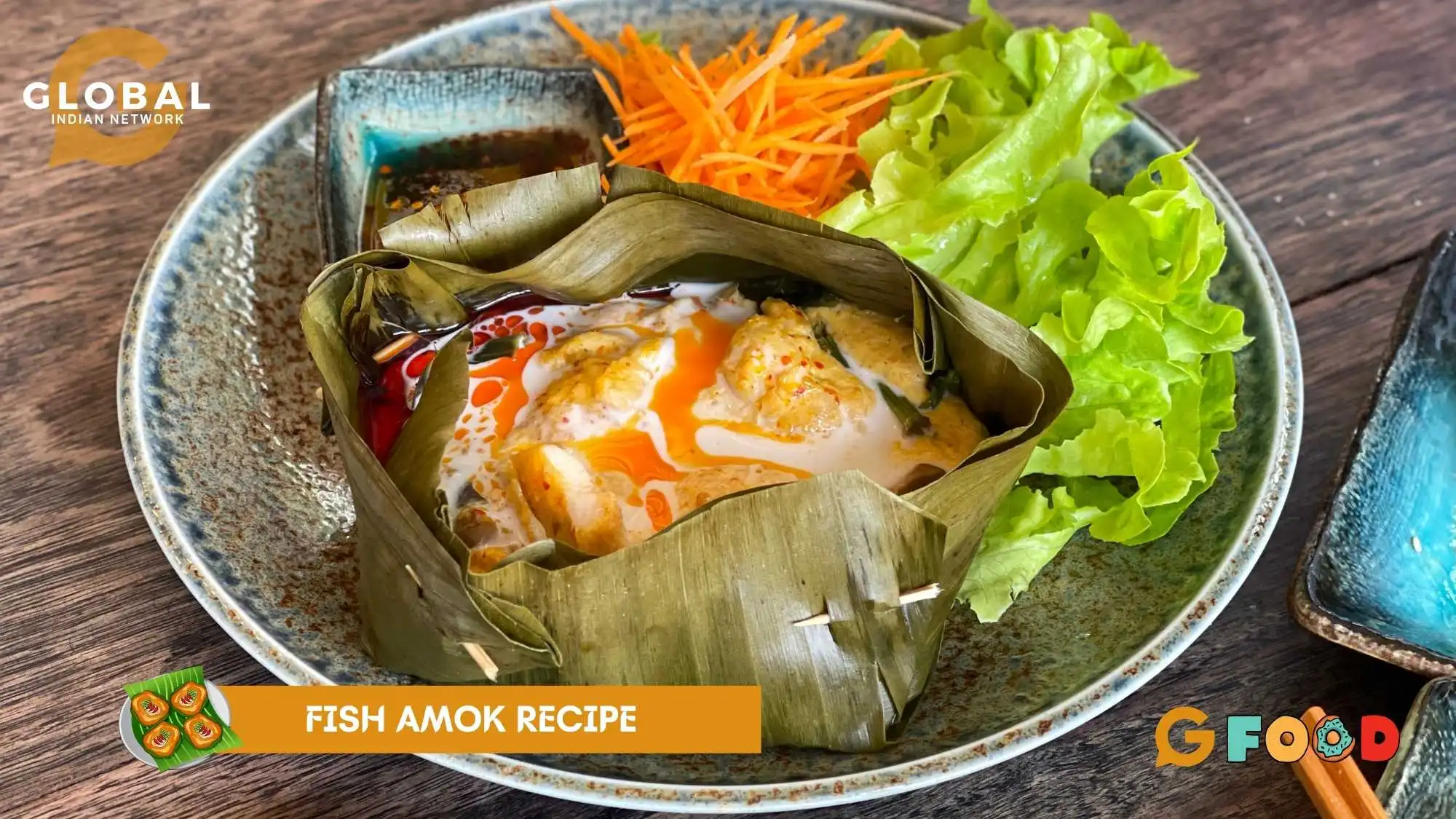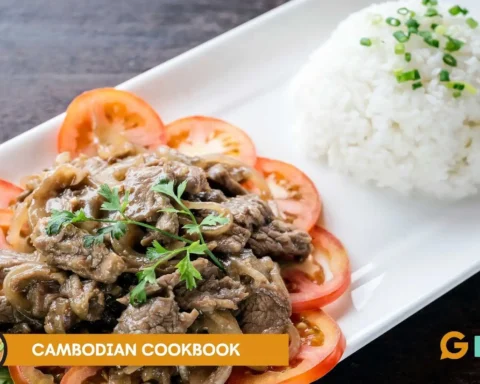Fish amok is more than just a meal; it’s a vibrant expression of Cambodia’s culinary tradition and cultural legacy. Known as the country’s national dish, fish amok is a delicately steamed fish curry that’s rich, smooth, and flavorful. Its blend of sweet, savoury, and mildly spicy notes reflects the complexity of Cambodian cooking, making it a great entry point for anyone exploring Southeast Asian cuisine.
This blog presents a beginner-friendly fish amok recipe that breaks down the traditional approach into simple, manageable steps that retain the dish’s authentic spirit while making it accessible to home cooks.
Table of Contents
Historical and Cultural Significance
Fish amok dates back to the golden era of the Khmer Empire, where it was often reserved for ceremonial and royal dining. It represents a bridge between Cambodia’s historical roots and its modern culinary scene. Traditionally made with freshwater fish and a fragrant spice blend, the dish is steamed in banana leaves and noni leaves- a method that brings out earthy aromas and underscores its sustainable roots. While modern kitchens may tweak the technique or ingredients, the core of the fish amok recipe remains unchanged: it’s a dish that speaks to both pride and tradition.
Ingredients
This fish amok recipe uses ingredients commonly available at Asian markets or specialty food stores. The heart of the dish is the amok curry paste, made from:
For the Curry Paste
- 2 stalks of lemongrass (white part only)
- 1 tsp turmeric or 1-inch piece of fresh turmeric
- 1 thumb-sized piece of galangal (or ginger as a substitute)
- 3 cloves garlic
- 1 kaffir lime leaf (or zest of 1 lime)
- 1 tsp shrimp paste (optional)
- 1–2 small red chillies (adjust to taste)
For the Fish Mixture
- 400g white fish fillets (such as tilapia or cod), thinly sliced
- 200ml coconut milk
- 1 tbsp fish sauce
- 1 tsp palm sugar (or brown sugar)
- A pinch of salt
- Additional kaffir lime leaves, thinly sliced
- Chinese broccoli or spinach leaves (for lining the bowls)
- Banana leaves or heatproof ramekins
Making the Amok Mixture
Using a food processor, begin by blending the curry paste ingredients into a smooth mixture. A splash of water can help achieve a more even consistency. Combine the curry paste with coconut milk, fish sauce, palm sugar, and a pinch of salt in a bowl. Stir until well blended into a smooth paste. This mixture serves as the flavorful base for the dish.
The aroma of lemongrass and lime leaves and the richness of coconut milk create a wonderfully balanced curry that complements the fish. Some cooks add more coconut milk for a creamier consistency or a few more lime leaves to emphasize citrus notes in the spice paste.

Preparing the Fish
Use fresh, white-fleshed fish cut into thin slices. Mix the fish into the prepared curry base and let it sit briefly to absorb the flavours. Line your ramekins or banana leaf bowls with leafy greens such as spinach or Chinese broccoli, then spoon the curry-covered fish into the containers.
Using banana leaves makes for a traditional presentation and adds a subtle herbal aroma during cooking. Whether you use banana leaves or heatproof bowls, the goal is to keep the mixture enclosed for even steaming.
Cooking Instructions
Place the filled bowls or banana leaf containers in a steamer. Steam gently for 20–30 minutes. The mixture will gradually set into a soft, custard-like consistency while the fish becomes tender and infused with the curry’s aroma.
If you don’t have a bamboo steamer, a metal steamer basket or a makeshift setup with a pot and lid will work. The key is slow, consistent steam that cooks the dish without drying it out. To enrich the dish further, some cooks use coconut cream instead of coconut milk. This gives the curry a denser, more luxurious texture. Adjust sweetness and saltiness by tasting as you go. Sometimes, a little extra sugar or fish sauce makes all the difference.
Adding lime leaves, whether shredded or whole, boosts the dish’s fragrance. These minor tweaks to the fish amok recipe help tailor the dish to your taste while preserving its authenticity.
Serving Suggestions
Fish amok is typically served with jasmine rice or steamed rice, which soaks up the rich curry and balances its flavours. For a colourful touch, garnish with finely sliced red chillies or additional lime leaves. If you’re using banana leaves, place them directly on a serving plate to showcase the dish’s traditional origins.
To balance its richness, consider pairing the dish with lightly sautéed greens or a fresh cucumber salad. Presentation matters, too, and an attractive garnish or carefully arranged plate enhances the overall experience.
For a deeper dive into Cambodian cuisine, joining a cooking class can be educational and fun. Classes in cities like Phnom Penh often include market tours, hands-on preparation, and traditional techniques like folding banana leaves and making curry paste from scratch. These experiences offer a fuller appreciation of the fish amok recipe and its place in Cambodian culinary culture.
You’ll learn directly from locals and pick up tips you might not find in cookbooks. This can include which types of Cambodian fish are most authentic or how to adjust spice levels without compromising flavour.
Fish Amok Recipe in Contemporary Cuisine
While firmly rooted in tradition, fish amok continues to evolve in modern kitchens. It’s been compared to dishes like Malaysia’s otak-otak, but the Cambodian version is known for its creaminess and subtle spice. Upscale restaurants and home chefs are reimagining the dish, experimenting with new proteins or presentation styles while staying true to the original flavour profile.
Contemporary chefs like Kethana and Mongkol have introduced creative spins on fish amok that keep it relevant for modern palates. Their approaches prove Cambodian cuisine is adaptable, flavorful, and worthy of global recognition.
Conclusion
This easy fish amok recipe introduces you to one of Cambodia’s most cherished culinary creations. Its rich curry base, fragrant spices, and gentle cooking method offer a warm and flavorful experience for any home cook.
Beyond just a recipe, fish amok is an invitation to explore Cambodian culture through food. Whether you’re learning from a cookbook, a local chef, or your kitchen experiments, making fish amok is a rewarding journey. And in the end, you’re left with a delicious meal and a deeper connection to the traditions and stories that make it special.










